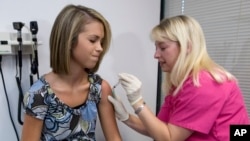Cervical cancer, a preventable sexually transmitted disease, kills an estimated 270,000 women each year, 85 percent of whom live in developing countries, the World Health Organization said.
More than a half million women each year become infected with the human papillomavirus, which causes cervical cancer, the U.N. agency said.
Marleen Temmerman, director of the WHO Department of Reproductive Health and Research, said that a safe, effective vaccine exists to stop the infection and that it's advisable for girls age 9 to 13 to get vaccinated before they become sexually active. The vaccine provides immunity for at least 10 years, and no booster shot is recommended.
“New studies have shown that, traditionally, we used to give three injections to the girls to immunize them fully," she said. "But we have shown now that two is enough, which is a major kind of step in the right direction because it reduces the number of injections and the cost.”
The cost of one HPV injection can be as high as $140, a price out of reach for most people in developing countries.
The World Health Organization said girls in more than 55 countries are protected by routine administration of HPV vaccine, and a growing number of countries are providing vaccine with support from the GAVI Alliance, a public-private global health partnership.
More methods are now available to screen women to identify pre-cancerous lesions. According to new guidelines, a woman whose screening proves negative needs only to be rescreened within 10 years, which represents a major cost savings for health systems.
The U.N. health agency said that more than 1 million women worldwide are living with cervical cancer, many with no access to curative treatment or palliative care. Temmerman attributed much of this situation to cost issues and to the low priority that many health systems place on dealing with this issue. But she said countries in eastern and southern Africa are developing national cancer survival plans.
“It is still at the pilot phase," she said, "so they do demonstration projects to show that HPV vaccination is feasible. Secondly, they do the testing. So they start with women who go to family planning, women who go to the health sector for other reasons. And in some of the countries, like in Kenya, they do now mobile clinic outreach.”
The objectives are to spread the message that cervical cancer is dangerous and preventable and to stress the importance of screening and treatment if cervical cancer is discovered.







